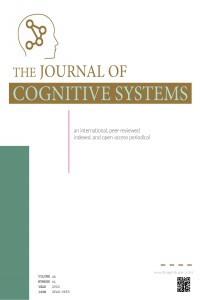Öz
Kaynakça
- Wong, N. D. (2014). Epidemiological Studies of CHD and the Evolution of Preventive Cardiology. Nature Reviews. Cardiology, 11(5), 276. Verma, L.,Srivastava, S., Negi, P. C. (2016). A Hybrid Data Mining Model to Predict Coronary Artery Disease Cases Using Non-Invasive Clinical Data. Journal of Medical Systems, 40(7), 1-7. Alizadehsani, R.,Hosseini, M. J., Sani, Z. A., Ghandeharioun, A., &Boghrati, R. (2012). Diagnosis of Coronary Artery Disease Using Cost-Sensitive Algorithms. In Data Mining Workshops (ICDMW), 2012 IEEE 12th International Conference on (pp. 9-16). IEEE. Srinivas, K.,Rani, B. K., &Govrdhan, A. (2010). Applications of Data Mining Techniques in Healthcare and Prediction of Heart Attacks. International Journal on Computer Science and Engineering (IJCSE), 2(02), 250-255. E. Smirnov, I. Sprinkhuizen-Kuyper, and G. Nalbantov, "Unanimous voting using support vector machines," in BNAIC-2004: Proceedings of the Sixteenth Belgium-Netherlands Conference on Artificial Intelligence, 2004, pp. 43-50. Nicholas, E. (2008). Introduction to Clementineand Data Mining. Brigham Young University Larose, D.T., and Larose, C.D. (2014) Discovering Knowledge In Data An Introduction To Data Mining, New Jersey: John Wiley&Sons. Quinlan, J.R. (1993) C4.5: Programs for Machine Learning, Morgan Kaufmann Publishers Inc. San Francisco, CA, USA. Platt, J. C. (1999). Fasttraining of support vector machines using sequential minimal optimization, advances in kernel methods. Support Vector Learning, 185-208. Azuaje, F. (2006). Wittenih, frank e: Veri madenciliği: Pratik makine öğrenim araçları ve teknikleri. Biyomedikal mühendislik çevrimiçi , 5 (1), 1-2. Valdimir, V. N.,&Vapnik, N. (1995). Thenature of statistical learning theory. Rosenblatt, F. (1958). Two theorems of statistical separability in the perceptron. United States Department of Commerce. Miller, D. J.,& Pal, S. (2007). Transductive methods for the distributed ensemble classification problem. Neural computation, 19(3), 856-884. Zhang, C.,&Ma, Y. (Eds.). (2012) Ensemble machine learning: methods and applications. Springer Science& Business Media. Polikar, R. (2012). Ensemble learning. In ensemble machine learning, Springer, Boston, MA, 1-34. Alpar, R. (2016). Uygulamalı istatistik ve geçerlik-güvenirlik: spor, sağlık ve eğitim bilimlerinden örneklerle. Detay Yayıncılık.
SAMPLE SIZE EFFECT ON CLASSIFICATION PERFORMANCE OF MACHINE LEARNING MODELS: AN APPLICATION OF CORONARY ARTERY DISEASE
Öz
Cardiovascular diseases are among the most common causes of death due to their widespread prevalence. Accurate and timely diagnosis of coronary artery disease, one of the fatal cardiovascular diseases, is very important. Angiography, an invasive method, is an expensive and special method used to determine the disease and can cause serious complications. Therefore, cheaper and more efficient data mining methods are used in the diagnosis and treatment of cardiovascular diseases. As an alternative approach, by establishing clinical decision support systems using data modeling and analysis methods such as data mining, errors and costs can be reduced by providing clinicians with computer-aided diagnosis, and patient safety and clinical decision quality can be significantly increased. In this study, the data set on the open-source access website was used to classify cardiovascular disease and consists of patient records of 14 variables created by the Cleveland clinic. Also, machine learning methods (C5.0 Decision Tree, Support Vector Machine, Multilayer Perceptron, and Ensemble Learning)were used to determine the risk of coronary artery disease by deriving 1000 and 10000 data sets from the cardiology data set obtained from original 303 patient records. Performance evaluation of models is compared in terms of accuracy, specificity, and sensitivity. In trying to determine the most successful model in estimating the risk of coronary artery disease, the results are presented comparatively.
Anahtar Kelimeler
Cardiovascular Diseases Sample Size Data Mining Ensemble Learning
Kaynakça
- Wong, N. D. (2014). Epidemiological Studies of CHD and the Evolution of Preventive Cardiology. Nature Reviews. Cardiology, 11(5), 276. Verma, L.,Srivastava, S., Negi, P. C. (2016). A Hybrid Data Mining Model to Predict Coronary Artery Disease Cases Using Non-Invasive Clinical Data. Journal of Medical Systems, 40(7), 1-7. Alizadehsani, R.,Hosseini, M. J., Sani, Z. A., Ghandeharioun, A., &Boghrati, R. (2012). Diagnosis of Coronary Artery Disease Using Cost-Sensitive Algorithms. In Data Mining Workshops (ICDMW), 2012 IEEE 12th International Conference on (pp. 9-16). IEEE. Srinivas, K.,Rani, B. K., &Govrdhan, A. (2010). Applications of Data Mining Techniques in Healthcare and Prediction of Heart Attacks. International Journal on Computer Science and Engineering (IJCSE), 2(02), 250-255. E. Smirnov, I. Sprinkhuizen-Kuyper, and G. Nalbantov, "Unanimous voting using support vector machines," in BNAIC-2004: Proceedings of the Sixteenth Belgium-Netherlands Conference on Artificial Intelligence, 2004, pp. 43-50. Nicholas, E. (2008). Introduction to Clementineand Data Mining. Brigham Young University Larose, D.T., and Larose, C.D. (2014) Discovering Knowledge In Data An Introduction To Data Mining, New Jersey: John Wiley&Sons. Quinlan, J.R. (1993) C4.5: Programs for Machine Learning, Morgan Kaufmann Publishers Inc. San Francisco, CA, USA. Platt, J. C. (1999). Fasttraining of support vector machines using sequential minimal optimization, advances in kernel methods. Support Vector Learning, 185-208. Azuaje, F. (2006). Wittenih, frank e: Veri madenciliği: Pratik makine öğrenim araçları ve teknikleri. Biyomedikal mühendislik çevrimiçi , 5 (1), 1-2. Valdimir, V. N.,&Vapnik, N. (1995). Thenature of statistical learning theory. Rosenblatt, F. (1958). Two theorems of statistical separability in the perceptron. United States Department of Commerce. Miller, D. J.,& Pal, S. (2007). Transductive methods for the distributed ensemble classification problem. Neural computation, 19(3), 856-884. Zhang, C.,&Ma, Y. (Eds.). (2012) Ensemble machine learning: methods and applications. Springer Science& Business Media. Polikar, R. (2012). Ensemble learning. In ensemble machine learning, Springer, Boston, MA, 1-34. Alpar, R. (2016). Uygulamalı istatistik ve geçerlik-güvenirlik: spor, sağlık ve eğitim bilimlerinden örneklerle. Detay Yayıncılık.
Ayrıntılar
| Birincil Dil | İngilizce |
|---|---|
| Konular | Elektrik Mühendisliği |
| Bölüm | Articles |
| Yazarlar | |
| Yayımlanma Tarihi | 30 Haziran 2020 |
| Yayımlandığı Sayı | Yıl 2020 Cilt: 5 Sayı: 1 |


